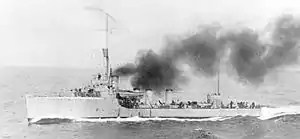Wrangel-class destroyer
The Wrangel class was a class of four destroyers of which two were cancelled built for the Royal Swedish Navy in Sweden during World War I. The two ships constructed were HSwMS Wrangel and HSwMS Wachtmeister. The two ships were in service until shortly after the end of World War II. Wrangel was disposed of as a target ship for testing and Wachtmeister was broken up for scrap.
 HSwMS Wachtmeister | |
| Class overview | |
|---|---|
| Operators | |
| Preceded by | Hugin class |
| Succeeded by | Ehrensköld class |
| In commission | 1916–1947 |
| Planned | 4 |
| Completed | 2 |
| Cancelled | 2 |
| Retired | 2 |
| General characteristics | |
| Type | Destroyer |
| Displacement | |
| Length | 69.6 m (228 ft 4 in) |
| Beam | 6.9 m (22 ft 8 in) |
| Draught | 2.8 m (9 ft 2 in) |
| Installed power | 13,000 ihp (9,700 kW) |
| Propulsion | Geared steam turbine, 2 screws |
| Speed | 34 knots (63 km/h; 39 mph) |
| Complement | 81 |
| Armament |
|
Overview
The Wrangel class completed a line of Swedish 30-knot (56 km/h; 35 mph) destroyers, originating from HSwMS Wale. Compared to contemporary destroyers in other navies, the Wrangel class was significantly smaller and lighter armed. However, they were improved versions of the preceding Hugin class and were the first Swedish destroyers to use single-reduction geared turbines.[1] The Wrangel class had a standard displacement of 415 tonnes (408 long tons) and 498 t (490 long tons) at full load. The destroyers measured 69.6 metres (228 ft 4 in) long at the waterline and 72.0 m (236 ft 3 in) overall with a beam of 6.9 m (22 ft 8 in) and a mean draught of 2.8 m (9 ft 2 in).[2][lower-alpha 1]
The Wrangels were powered by steam provided by four coal-fired Yarrow boilers, each with their own uptake, to two de Laval geared turbines, each turning one shaft, designed to create 11,000 shaft horsepower (8,200 kW)[1] but actually created 13,000 shp (9,700 kW).[2] Each turbine had their own engine room with the foremost turbine turning the starboard shaft.[1] The ships carried 105 t (103 long tons; 116 short tons) of coal and in 1927, they were converted to oil burning and carried the same amount of fuel oil.[2] This gave them a maximum speed of 34 knots (63 km/h; 39 mph). The destroyers had a complement of 81 officers and ratings.[1][2]
The destroyers were armed with four single-mounted 75-millimetre (3.0 in)/53 M12 guns.[2][lower-alpha 2] One gun was situated fore, one aft and one to either side of the ship along the beam.[1] They also mounted two 6.5 mm (0.26 in) M14 machine guns and six torpedo tubes for 457 mm (18 in) torpedoes.[2] Four of the torpedo tubes were located in pairs and two single mounts were located abreast the second and third funnels to each side.[1]
Modifications
Aside from the update to the fuel, the Wrangels were rearmed in 1940, retaining their four 75 mm guns and adding one 25 mm (0.98 in)/44 M32 anti-aircraft gun and two 8 mm (0.31 in) M36 anti-aircraft guns while having their two single-mounted torpedo tubes removed. This led to an increase in displacement, with their standard displacement rising to 498 t (490 long tons).[2]
Ships in class
| Construction data[1][2] | |||||
|---|---|---|---|---|---|
| Name | Builder | Launched | Commissioned | Stricken | Fate |
| Wrangel | Lindholmens, Gothenburg, Sweden | 25 September 2017 | 4 May 1918 | 13 May 1947 | Used as a target ship; sank 1960 |
| Wachtmeister | 19 December 1917 | 19 October 1918 | 13 June 1947 | Sold for scrap, 1950 | |
| Ehrensköld | Cancelled | ||||
| Nordenskjöld | |||||
Construction and career
Four ships were authorised in 1914 at the beginning of World War I. However, the final two ships of the class were cancelled due to economic reasons. Constructed in Sweden, HSwMS Wrangel and HSwMS Wachtmeister were both laid down in 1916 and completed in 1918. They were initially given the pennant numbers 9 and 10 respectively, but in 1940, these were changed to 25 and 26 respectively.[2] Both destroyers saw little action during their service due to Sweden's neutrality during both world wars beyond sailing on neutrality patrols.[3] Wrangel was stricken for the Navy Directory on 13 May 1947. The vessel was used as a target ship for tests and was sunk in 1960. Wachtmeister was stricken on 13 June 1947 and sold for scrap in 1951.[2][lower-alpha 3]
Notes
- Whitley has the ships with a standard displacement of 472 t (465 long tons), an overall length of 70.9 m (232 ft 7 in) and a beam of 6.7 m (22 ft 0 in).[1]
- /53 describes the gun's calibre and denotes the length of the gun. This means that the length of the gun barrel is 53 times the bore diameter.
- Whitley has them both stricken on 13 June 1947.[1]
Citations
- Whitley 2000, p. 247.
- Gardiner & Gray 1985, pp. 360–361.
- Whitley 2000, pp. 247–248.
References
- Gardiner, Robert & Gray, Randal, eds. (1985). Conway's All the World's Fighting Ships 1906–1921. London: Conway Maritime Press. ISBN 0-85177-245-5.
- Whitley, M. J. (2000) [1988]. Destroyers of World War Two: An International Encyclopedia. Annapolis, Maryland: Naval Institute Press. ISBN 0-87021-326-1.